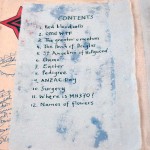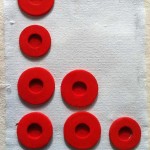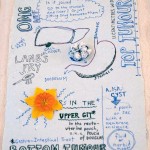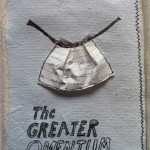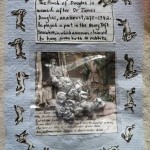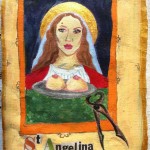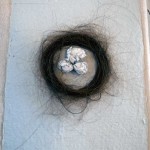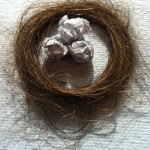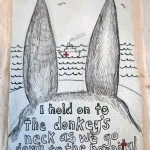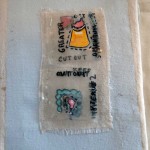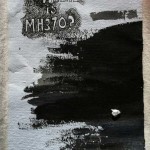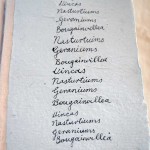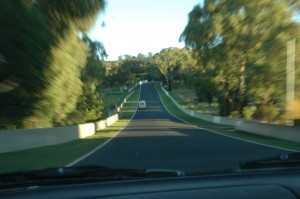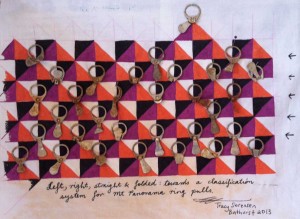The thing about baldness is that you have a blank palette from which to begin to create new looks. I’ve never been much bothered with new looks – I wore straight brown hair parted down the middle forever – but now that I’ve been led here by chemo-induced baldness I’m quite enjoying it. I went to a friend’s place for dinner last night in a cloche hat and curly red hair and a big green vintage coat. I watched as a very close friend’s eyes skated over me without recognition. I was invisible; someone new; someone else. A fly on the wall; an occupier of liminal space. But then she did recognise me and everything jolted back to normal. We resumed our long-running discussions about art, illness and crochet.
Then I hobbled home in the dark. My left knee has been giving me hell. I think the chemo is eating away at my cartilage, or I have fluid retention, or something. And so I return to Dr Google, typing in search terms like “sore knee chemo” to see what others have to say on the subject. What they say is that chemo often causes sore knees. Besides the knee, I’m in a bit of a dip all round. Everything is an effort, today. I’m in slow motion. Next Wednesday, I’ll be having another CT scan to see what the three rounds of chemo have done to my tumours. I’m alternating between confidence and apprehension.
Last Tuesday, after a wild weekend with my relatives (enjoyable wildness involving two small boys, possum hunting and a dramatically crashing and splintering glass object in a shop that had to be paid for), I took my Waste to Art entry up to the Flannery Centre for the exhibition that opens tomorrow. As a work of art it’s lumpy and unresolved (aka ugly) but as a project it has been enormously satisfying. And through it, I’ve discovered pen and ink! The kind you have to keep dipping into an ink well. Oh fun! Oh beautiful scratchings! Here it is:
- A new journal created from the old. Each page is made of paper recylced from an old journal. The pages are bound together with lengths of an old bed sheet.
- An introduction on the inside sleeve.
- The Table of Contents.
- Red Blood Cells. This is where it all began: I was pale and anaemic, and my GP sent me off for tests. These were made from the little donut-shaped cushions you find in blank CD or DVD towers.
- OMG WTF. In the morning, I just a person with anaemia; by the afternoon I’d become a fully-fledged member of the Dangerously Ill club, but there was not, as yet, a diagnosis.
- The Greater Omentum. With a diagnosis of primary peritoneal cancer, a form of ovarian cancer associated with the BRCA1 gene mutation, I discovered that I would probably lose my greater omentum. I hadn’t ever heard of the greater omentum.
- The Pouch of Douglas. My bottom tumour’s location was in the Pouch of Douglas. Again, I hadn’t been aware that I even had one. The Pouch of Douglas was first described by the Scottish anatomist James Douglas way back at the end of the 17th century. Douglas got caught up in the Mary Toft sensation, in which a woman had claimed to give birth to rabbits. Douglas called her out on it, saying she had as much liklihood of giving birth to rabbits as a rabbit would be to give birth to a human child. She was found to have put baby rabbits up herself, mimicked labour and called her local doctor, who believed her. Thanks to Mum for cutting out and sticking down all the little rabbits. The original drawings are by William Hogarth; work in the public domain, retrieved from Wikipedia.
- St Angelina of Hollywood. This is a mash-up of Angelina Jolie with images of St Agatha, a Christian saint who was tortured by having her breasts pinched off with pincers. Angelina Jolie has the BRCA1 gene mutation and has had a double mastectomy and plans to have an oopherectomy (removal of ovaries) to reduce her risk of cancer. Such surgery vastly reduces risk but doesn’t, as I have unfortunately found, eliminate it.
- Chemo.
- Easter. Little bits of scrunched up paper from my old journal represent cancer. I kept a bit of the hair that fell out of my head after chemo. This piece is reminiscent of a crown of thorns, but also a nest with eggs in it.
- Easter (detail).
- Pedigree. This was the most moving of all the pages I made for this journal. It shows the flow of the BRCA1 gene mutation from my grandfather (Pop) on my father’s side, down through Dad and his sister Joyce, and on to the next generations. The young children have question marks under their names, because we don’t yet know if they have inherited the BRCA1 gene mutation. My cousin Sharon died of ovarian cancer in the 1990s.
- ANZAC Day. On ANZAC day I always think of Simpson and his donkey, because that was what fired my imagination when I first heard about the Gallipoli landing in primary school. This year, I felt the bodily suffering of Easter and ANZAC Day more intensely than ever before.
- Surgery. Surgery has been set down for May 13, although this may change. You can turn the little plastic sheets (representing the “glistening, transparent peritoneum”) to reveal abdominal organs, some of which will be cut out, and others that will be kept. Some, like the stomach or the liver, may be snipped at around the edges.
- Where is MH370? For me, these weeks will always be associated with the endless, unsuccessful search for the Malaysian airlines plane that went missing in the vast Indian Ocean. A reminder of how little we can really control or know about.
- Names of Flowers. Sometimes when things are really difficult, I find myself repeating the names of my favourite flowers. They’re all hardy flowers, the ones I grew up with in subtropical Carnarvon, WA.
- The journal can be displayed like this. I’m hoping those setting up the exhibition will allow people to touch the piece and turn the pages.


